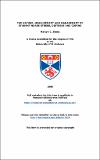Files in this item
The nature, measurement and management of student nurse stress, distress and coping
Item metadata
| dc.contributor.author | Jones, Martyn C. | |
| dc.coverage.spatial | 371 p. | en_US |
| dc.date.accessioned | 2015-08-18T14:36:55Z | |
| dc.date.available | 2015-08-18T14:36:55Z | |
| dc.date.issued | 1998 | |
| dc.identifier | uk.bl.ethos.246880 | |
| dc.identifier.uri | https://hdl.handle.net/10023/7279 | |
| dc.description.abstract | Following a review of the stress, distress and coping reported by student health professionals and students in higher education, see Chapters 2 and 3, the hypothesis that a problem existed with distress early in training was confirmed by screening two cohorts of first year student nurses, see Chapter 4. Some 50.5% of students, in Cohort one (N=109, Week 40) and 67.9% of students in Cohort two (N=111, Week 24) suffered significant levels of affective distress. All students were enrolled on the newly implemented 1992 scheme of nurse education in Tayside. The underlying dimensions of situational sources reported by student nurse stress were clarified with the development of the Student Nurse Stress Index, see Chapter 5. A reliable 22 variable solution with oblique structure and non-orthogonal factors of "academic load", "clinical sources", "intet/ace worries", "personal problems" was obtained. This measure showed cross sample factor congruence, good internal reliabilities, and concurrent and discriminant validity across a range of reporting conditions. A stress reduction/management intervention set at individual and interface levels, designed to reduce levels of student nurse distress revealed by the earlier screening study, was implemented during a second series of hospital placements, see Chapter 6. A randomised controlled trial revealed the success of this programme in reducing affective distress in 73 student nurses shown to have experienced significant levels of distress earlier in training. A series of significant treatment x time interactions were found with a range of context-free measures of affective distress, e.g. General Health Questionnaire-30 (Goldberg, 1972), State and Trait Anxiety Inventory (Speilberger, et aI., 1983), Beck Depression Inventory (Beck, et aI., 1987), with situational sources of stress (Beck & Srivastava, 1991), and Domestic Satisfaction (Derogatis, 1980). Similar treatment x time interactions were found with Direct Coping (Parkes, 1984), and Relaxation Potential (Derogatis, 1980). Adaptive changes were confmed to the experimental group alone. In addition, State Anxiety on the morning of an important exam was lower for students receiving stress management (Treatment X= 45.88, Control X =59.09). The intervention had no detectable effect on organisational variables of sickness, absence and examination performance. However, logistic regression and hierarchical multiple regression analysis showed that initial distress at screen did not predict pre or post-treatment changes in sickness or absence, or subsequent examination performance. Stress management delivered in groups reduced affective distress and increased adaptive coping use in both clinical and academic settings. Possible future directions for this research targeting student nurses are outlined in Chapter 7. | en_US |
| dc.language.iso | en | en_US |
| dc.publisher | University of St Andrews | |
| dc.subject | Industrial medicine | en_US |
| dc.subject | Industrial hygiene | en_US |
| dc.subject | Medicine | en_US |
| dc.subject | Industrial | en_US |
| dc.subject.lcc | RC455.4S87J7 | |
| dc.title | The nature, measurement and management of student nurse stress, distress and coping | en_US |
| dc.type | Thesis | en_US |
| dc.type.qualificationlevel | Doctoral | en_US |
| dc.type.qualificationname | PhD Doctor of Philosophy | en_US |
| dc.publisher.institution | The University of St Andrews | en_US |
This item appears in the following Collection(s)
Items in the St Andrews Research Repository are protected by copyright, with all rights reserved, unless otherwise indicated.

